Learn everything you need to know about product adoption—what it is, each stage of the process, how to measure it, and how to optimize your product to maximize adoption.
Every new signup for your product is a great feeling. It’s the satisfaction of building a product from the ground up, finding potential users, and successfully selling them on what you have to offer. But out of all of those signups, how many will stay for a week, a month, or even a year? How many will truly embrace your product, share it with their friends, and become the brand advocates you’ve always dreamed of?
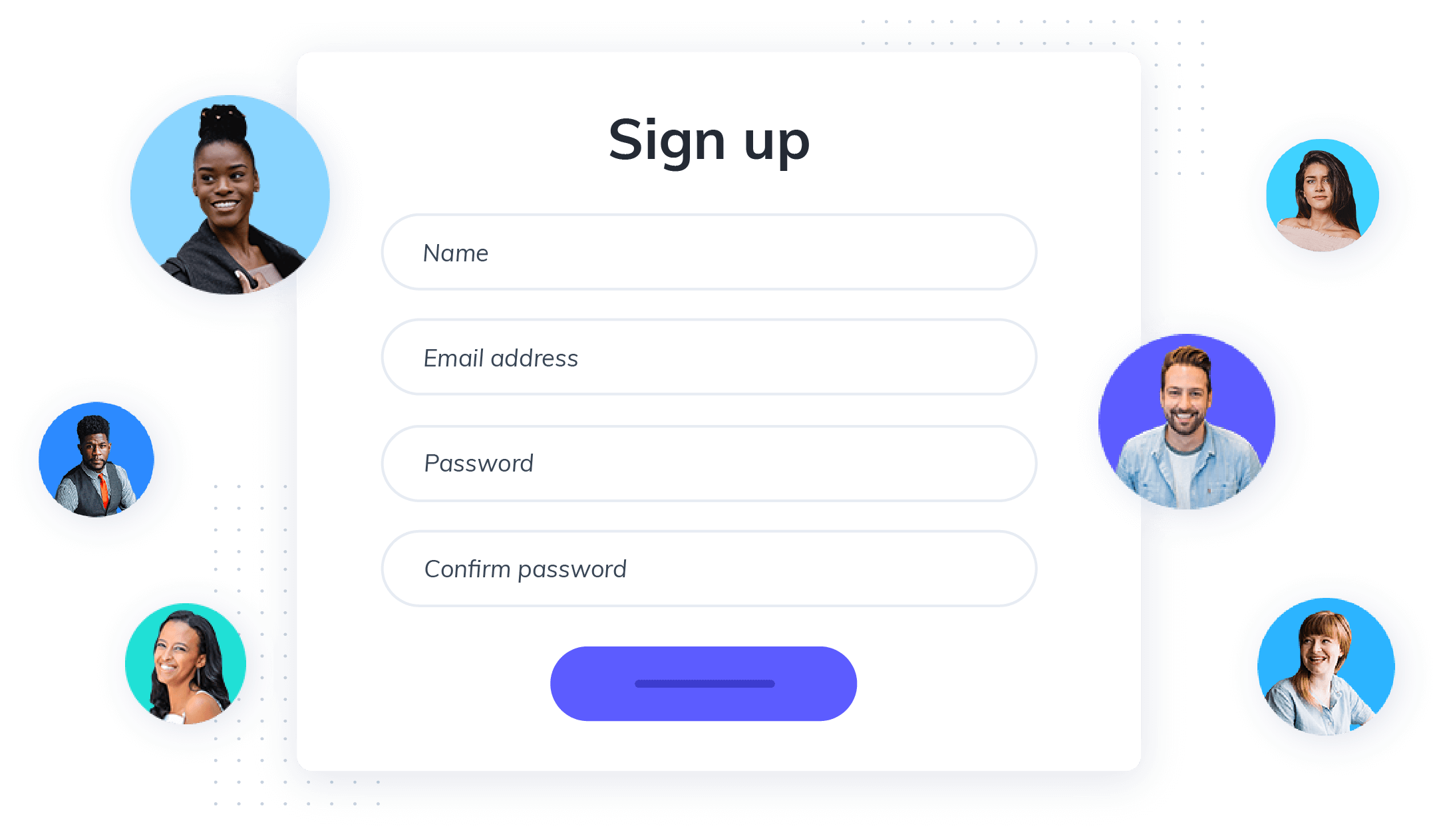
That depends on you and how well you can optimize your product to maximize product adoption—in other words, how well you can convert newcomers into the dedicated users you need to power your business. Other metrics like MRR (monthly recurring revenue), total users, or churn rates might give you a sense of the health of your business—but they won’t tell you the whole story. For that, you’ll need to dig deeper, pulling in multiple metrics to understand how efficiently you’re encouraging users to adopt your product into their lives.
This ultimate guide will teach you everything you need to know about product adoption—what it is, each stage of the process, how to measure it, and how to optimize your product to maximize adoption. By the end, you’ll be an expert in guiding each of your potential users, from their free trial through early product adoption to brand advocacy.
So, if you’re sick of seeing new users churn before they hit their first month, let’s start changing that right now.
Product adoption is the end result of a journey your users undergo as they learn about your product, give it a try, and finally embrace it as their go-to tool for solving their problem. Product adoption is not the same as product activation. Product activation is the first step on a user’s journey to adoption—the moment when they first achieve something with your product.
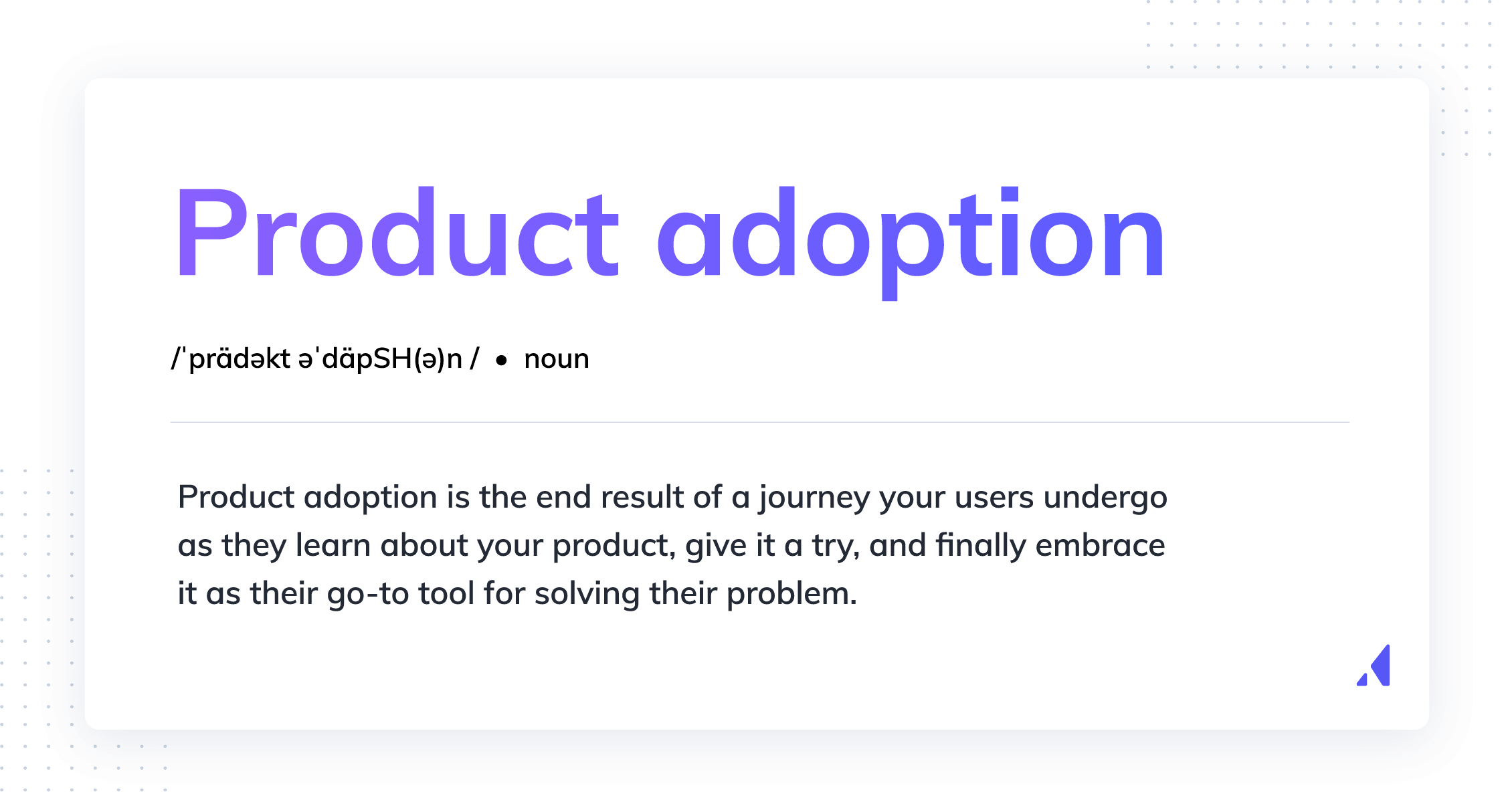
The end result of product adoption may look different for each product—whether it’s logging in daily to check recent stock figures or once a year to update life goals. Regardless of the problem your product solves, adoption adds up to the same thing: your product is your users’ preferred way to get something done.
Product adoption is an odyssey of perfect messaging, free trials, insightful onboarding, and a whole host of other tasks, all competing for users’ attention. If you’re too slow or you miss a single step, they’ll look elsewhere. Do it right, however, and you can increase retention and build a following of people who love your product and share it with the world.
Put simply, product adoption is important because it’s an early indicator of retention. Successful product adoption not only improves retention rates, it also generates organic and repeatable expansion opportunities.
If net revenue retention is important to your business (and trust us—it is), pay attention.
Churn is the final event in a customer’s life cycle. All opportunities to retain a customer must logically fall before they end their relationship with your product. Yet the majority of businesses attempt to improve retention through a reactive approach. It’s possible to save an at-risk customer with 90 days of intense focus, but such an effort is neither sustainable nor scalable.
The same is true when it comes to upgrade- and expansion-driven revenue. Much like waiting until an account is at-risk to address it, running ad hoc upgrade campaigns to hit short-term targets is unscalable and often labor intensive.
Fortunately, there’s a better way. Prioritizing product adoption is the best way to get ahead of churn and boost revenue. As users become more invested, your product becomes more ingrained in their day-to-day lives. This increases the value of your product and creates happier, more satisfied customers. Switching vendors becomes less attractive and renewals become easier. If you’re improving adoption, users will be more receptive to expanding. Additionally, effective packaging and pricing increases the likelihood of your users running into more paywalls.
Your product adoption strategy helps unify the different parts of your team and orient them toward the same goal. Oftentimes, instead of being on 1 team, companies see different departments, like customer service, marketing, or product management, as different groups with different goals, all in their own neat little boxes. Good onboarding goes here, product launches go there, and email marketing fits in the cabinet over the fridge.
When you silo like this, what should be a unified team turns into a bunch of mini-teams pulling in different directions. Your product marketing team might focus on acquiring more of Person A while your onboarding is built for Person B. This disconnect could get otherwise-ideal users to churn quickly when their expectations aren’t met.
When everyone is on Team Product Adoption, product marketers and product managers are communicating, identifying the strategies that bring in qualified leads, and designing onboarding flows that set users up for success. Everything you do and create works together to achieve one goal: get more people to love and embrace your product.
When this is all done correctly, product adoption results in sustainable growth in your user base. Instead of having a constant revolving door of signups that quickly turn into churns, product adoption strategies reduce churn, so each new cohort of signups builds on the numbers of the previous ones. Slowly but surely, you’ll establish a user base with a core of dedicated users, giving you advocates that can help you promote your product and increase the average lifetime value of your user base as a whole.
Traditionally, product marketers have divided the product adoption journey into five clear stages:
1. Awareness
The user is first introduced to your product.
2. Interest
The user learns more about the product and its top-level features.
3. Evaluation
The user compares your products with others to determine whether yours is the best one for them.
4. Trial
The user tries out your product before making a long-term commitment.
5. Adoption
The user embraces your product as the best solution to whichever problems it solves.
We humbly suggest that this traditional 5-stage model is not as relevant as it once was. Nowadays, with the advent of product-led growth as a popular business strategy, how people adopt new products has changed. We need to update our understanding of the product adoption journey so that we can help users every step of the way.
In our new framework, the 5 critical stages of product adoption are evaluation, activation, adoption, expansion, and advocacy. The most significant—and obvious—updates are the removal of awareness and interest stages, as these are early stages of acquisition, not adoption. Stronger acquisition strategies drive product adoption by bringing in more relevant users who are likely to adopt your product. But the actual process of driving product adoption begins the moment a new user signs up for your product.
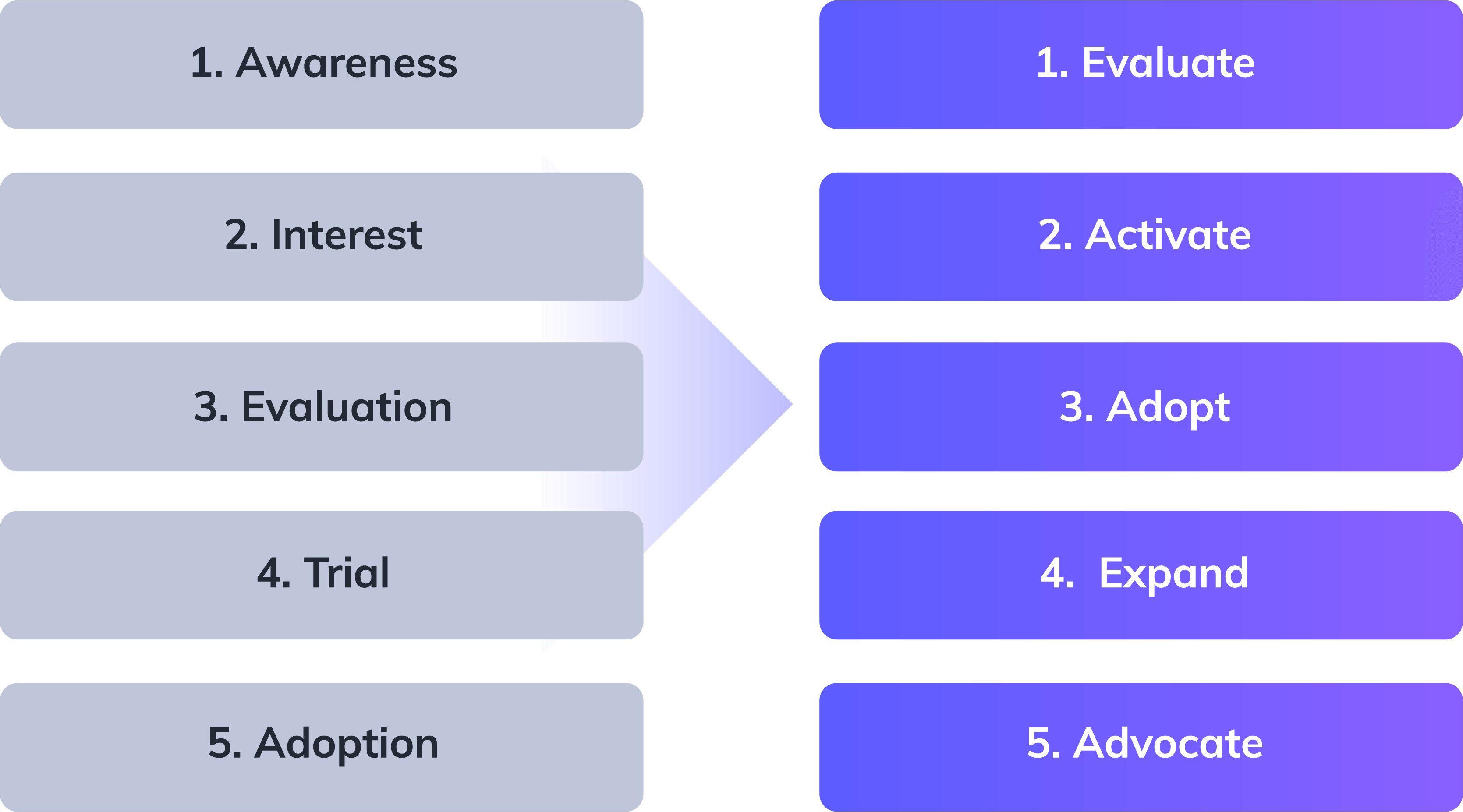
By splitting acquisition from adoption, your business can better nail down each of these processes. Acquisition can focus on bringing in new users, while adoption can work at converting them into complete brand advocates.
Understanding the 5 new stages of product adoption, what they look like, and what you need to do to get users to that next stage helps ensure that each user’s product adoption journey is as quick and smooth as possible.
Users start in the evaluation stage when they begin looking for a solution to help them with a problem. They’re either compelled by your marketing or have heard great things about your product from others—but they don’t have a relationship with your product just yet.
At this stage, these users are still casually browsing and not ready to schedule a demo or sign up for your product. As they go through the process of evaluating products (including your competitors) they might: visit your website, download your whitepaper, review your pricing information, etc.
Users enter the activation stage when they try out your product with a demo, free trial, or something similar. Oftentimes, people who start a free trial don’t really know much about your product, so this is your chance to educate them and convince them of the benefits of your product.
To succeed in this stage, you need to nail your free trial’s onboarding experience. The main goal of onboarding is to get people to their aha moment—or activation—as quickly as possible, meaning the light bulb turns on, and the user understands why your product makes sense for them.
A successful new user onboarding experience should:
• Introduce users to your product and its feature(s).
• Teach them how to use the feature(s).
• Demonstrate how using your product will bring value to them.
This requires you to know what aha moments your users might have and then guide them to these moments with clever UX. Different users may have different aha moments depending on what they’re looking to get from your product. For example, the insurance company Lemonade knows that their users’ aha moment is getting an insurance quote quickly, easily, and online. That’s why they get users from signup to a quote in about 90 seconds in their onboarding.
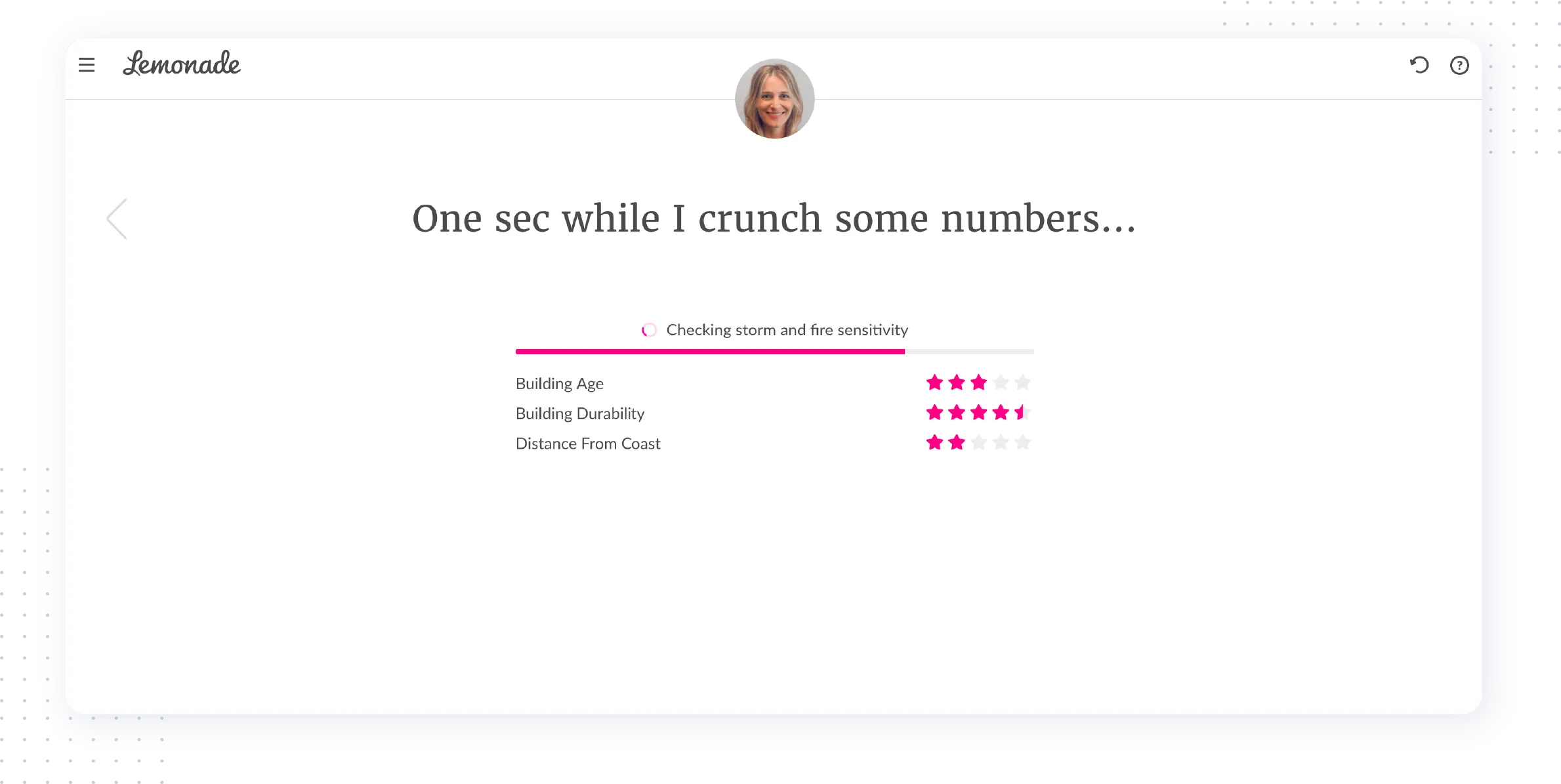
You may not be able to get your users to their aha moment that quickly. But your goal should be to get them there sooner rather than later. Successfully guide users to their aha moments, and it’ll be far more likely that they’ll stick around after their trial period ends.
You can learn more about mastering this skill in our guide to onboarding best practices.

Users enter the adoption stage when they reach their aha moment and realize the value a product brings to them. At this point, using your product is still not a part of their daily workflow, so they can still easily churn.
In this stage, you need to encourage users to make using your product an ingrained habit, like checking their emails in the morning or in the afternoon or every five minutes (we get a lot of emails).
Make your product their go-to solution by:
• Having easy-to-access resources for questions users might have
• Encouraging users to reach additional aha moments through messaging that showcases new use cases for your product
• Using motivation tactics like gamification to encourage frequent product use
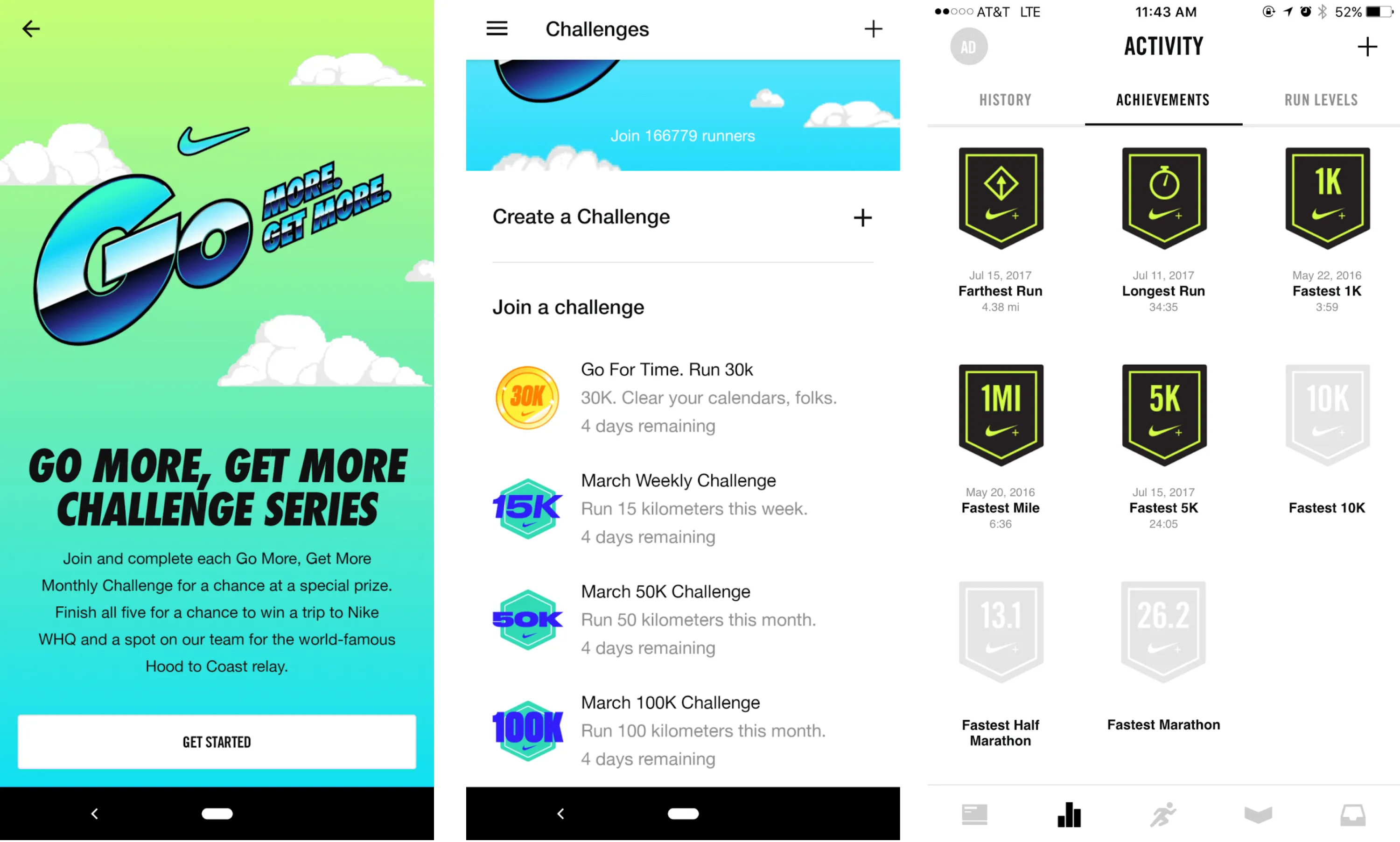
Nike Run Club incentivizes users to complete challenges through community involvement and achievements.
As a wise man once said, give a man a product, and you help him for a day. Teach that man to use your product every day, and you have a successful SaaS product (or something like that).
Doing this well decreases churn rates and helps upsell users to increase their value to you. It’s often easier to get more value from existing customers than getting new ones, so don’t neglect users once they’ve adopted your product.
People enter the expansion stage when they use the product frequently and enjoy it to the point where they want to do more with it. Expansion can be difficult to optimize for because people don’t announce they’re ready to learn and do more with your product.
To succeed in this stage, you need to understand the signs that people are ready for more and perfect your messaging to entice them into expanding. Plus, you’ll need to figure out what areas different users are most likely to want to expand into.
This means:
• Showing users new use cases for your product that can specifically help them
• Getting users more involved with other parts of your product
• Upselling them into pro plans
It’s always easier to use one product for multiple uses than to start using a whole new product. It’s why Amazon was easily able to expand from a used bookseller to a goliath that brings us groceries, laptops, and original programming. So use your knowledge of your user base and targeted messaging to encourage people to truly use your product to its fullest potential, and you’ll quickly find your users reach the last stage in the product adoption journey.
People enter the advocacy stage when they’re inviting other users to the product, leaving reviews, and actively evangelizing for your product. Not only are these people dedicated users who are unlikely to churn, but they’ll also act as free marketing and lead generators to bring in even more business.

With advocacy, you need to make it as easy as possible for users to start singing your praises publicly. You don’t need to send them their own monogrammed cheer squad outfit (unless you think it’ll help), but you can create incentives and opportunities to get the ball rolling.
These can include:
• A brand ambassador program that comes with perks like early access to new features
• Incentives for referring new users
• Social media communities where brand advocates can communicate with you and each other
By succeeding in this stage, you complete the product-led growth flywheel by driving awareness and evaluator interest in your product. More advocates will drive more acquisition, which in turn will lead to more users and brand advocates that will power your business and bottom line.
Driving product adoption isn’t simple, and it won’t look the same for every company. You want to use every tool at your disposal to demonstrate to users the value of your product.
Here are some clear tactics we’ve found that lead to success (beyond just making a kick-butt product—we assume you’ve already got that covered).
With product adoption, what different users need won’t always be the same, so don’t treat them the same.
Segmentation allows you to see how different parts of your audience are reacting to your product. With this info, you can personalize each group’s experience, offering them the resources they need to move through each of the stages of product adoption.
There are a couple of ways to segment your audience. You can consider their demographics, their reason for using your product, or even the kind of product adopters they are (are they groundbreaking early adopters, or are they late hold-outs).
Once your audience is segmented, personalize the experience of your users throughout their entire product adoption journey:
🔎 Evaluation
Make your pricing information easy to find so users can quickly evaluate if your solutions meets their needs and budget.
🚀 Activation
Personalize your free trials and onboarding flows to wow your new users with aha moments that are meaningful to that segment.
👉 Adoption
Use data to understand which features a segment isn’t using, then focus resources on getting them to embrace new ways of using your product and enhancing its value in their eyes.
📈 Expansion
Find expansion opportunities that are most effective for that segment. If Segment A is most likely to adopt Feature Y first and Feature Z second, then design a modal that introduces users to Feature Z at a time when they’re ready to expand.
💜 Advocacy
Optimize advocacy opportunities and how you introduce segments to them.
An example of a company that does segmentation well is Duolingo. Duolingo is a language learning app that has users segment themselves in the evaluation stage. Users are asked to pick the language they’re interested in learning, their skill level, and their reason for learning a language. Using this data, Duolingo offers users a better in-app experience. When users want to learn, they don’t have to fiddle with finding the perfect lesson; they just have to log in and get started on the lessons picked for them by Duolingo based on their interests and language abilities. With lessons targeted at their needs, users should get to their aha moment more quickly.

To learn more about segmentation, you can look at:
• How to craft targeted messaging with user segmentation
• Easy segmentation tactics using a real example from Appcues onboarding
• How Toast uses Appcues to deliver personalized user experiences
Users are your single most valuable resource for finding and improving on friction points in every stage of product adoption. Uncertain if an email is hitting right? Check the click-through rate and adjust. Not sure if your onboarding is clear enough? Use event tracking to see whether users make it through your onboarding process and then make changes to instructions or tooltips to help reduce high drop-off rates.
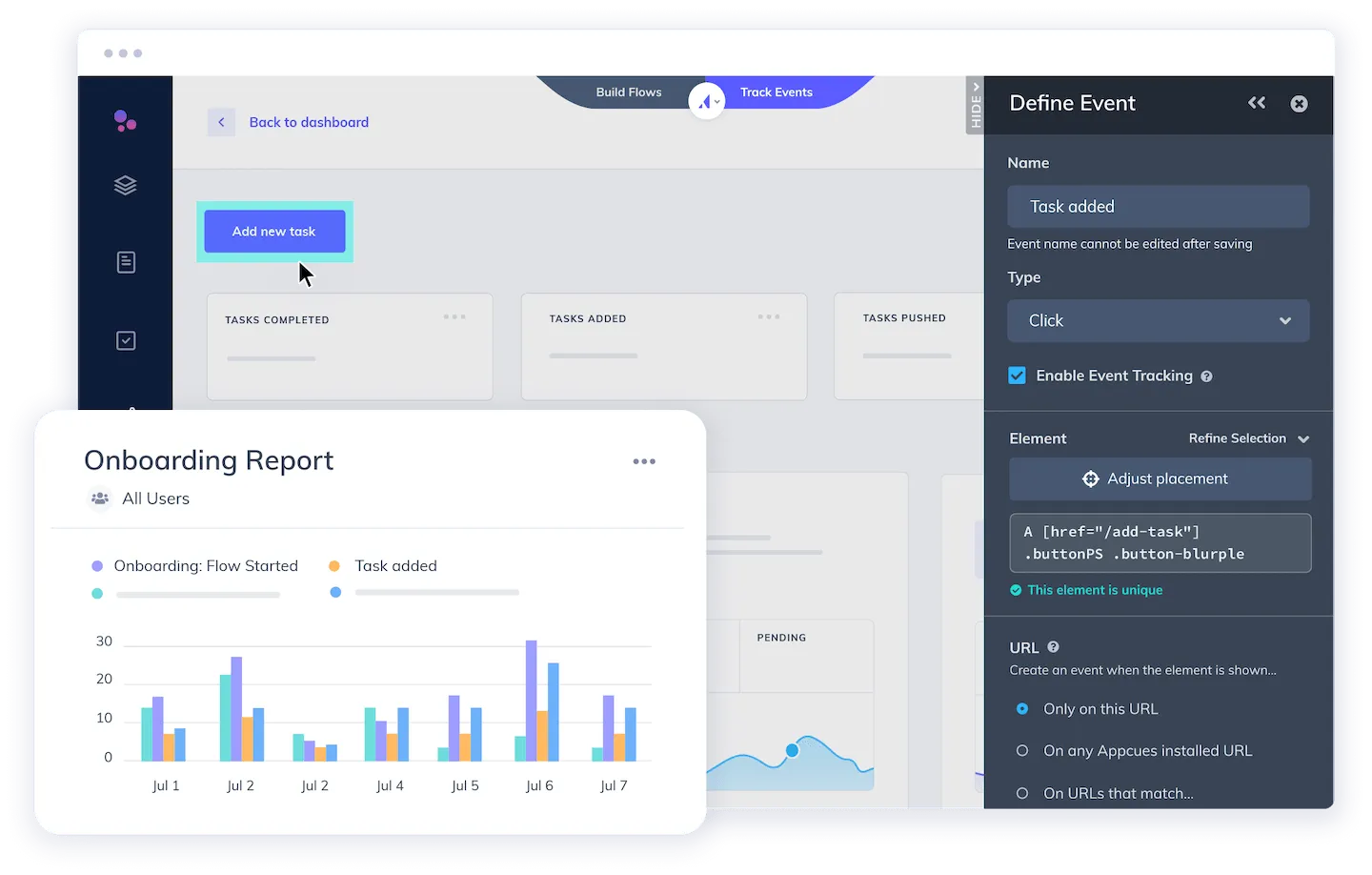
By listening to users, either when they explicitly tell you or through their actions using your product, you can make the product adoption journey better by optimizing their experience, reducing friction points, and helping them get to the point of brand advocacy quicker. Customer feedback is often used for fixing a product directly, for example, through suggestions to improve features or onboarding, but it can help you foster advocacy as well.
To get more customer feedback:
• Make it easy for users to get in touch with you to leave comments, suggest a new feature, or just air general grievances
• Use microsurveys for immediate feedback
• Collect data from your helpdesk to see which snags are holding people back
The eHealth platform PatientSky found they were having problems getting people through the evaluation stage, so they turned to happy users for help. They did this by asking users with an NPS score of 8 or higher if they would give a reference. Within one week, they’d already received 2 references they could use to convince more people to try their services.
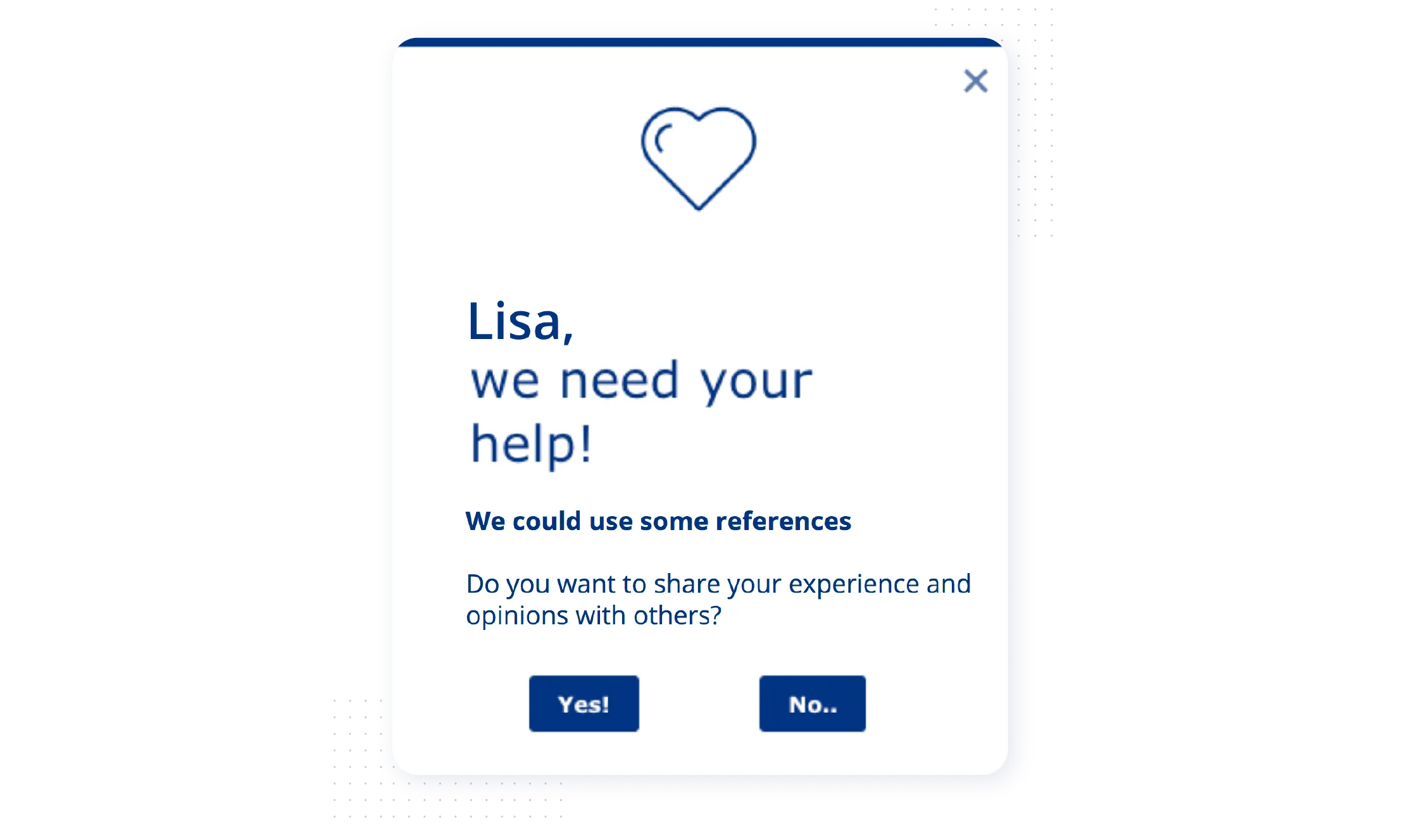
*This flow has been translated from the original Norwegian
To learn more about listening to users and collecting product feedback, you can explore:
• How to get qualitative user feedback to improve onboarding
• 6 ways PMs can collect, analyze, and leverage user feedback more effectively
• 6 outstanding examples of in-app user surveys, customer feedback forms, and NPS
Each feature you have should offer users value when used correctly. If you get people to see that value, it adds to the overall worth of your entire product, making it more likely for users to adopt your product and keep on using it for the foreseeable future.
To improve feature adoption, you should:
• Listen to user feedback to see if you can make a feature more useful and valuable to users
• Use event tracking to understand which features are getting used and by which segments of your user base
• Improve your onboarding to teach users how to use it and guide them to their aha moment
• Announce new features so new and existing users know these features exist
When the collaborative app Airtable has a new feature, they don’t quietly bury it in a menu—they trumpet its existence across their domain. When new users logged in after Airtable released their “Blocks” feature, they were greeted with a modal that told them about their new feature. Interested users could click to learn more or see the documentation to get right into using it to get even more out of Airtable.
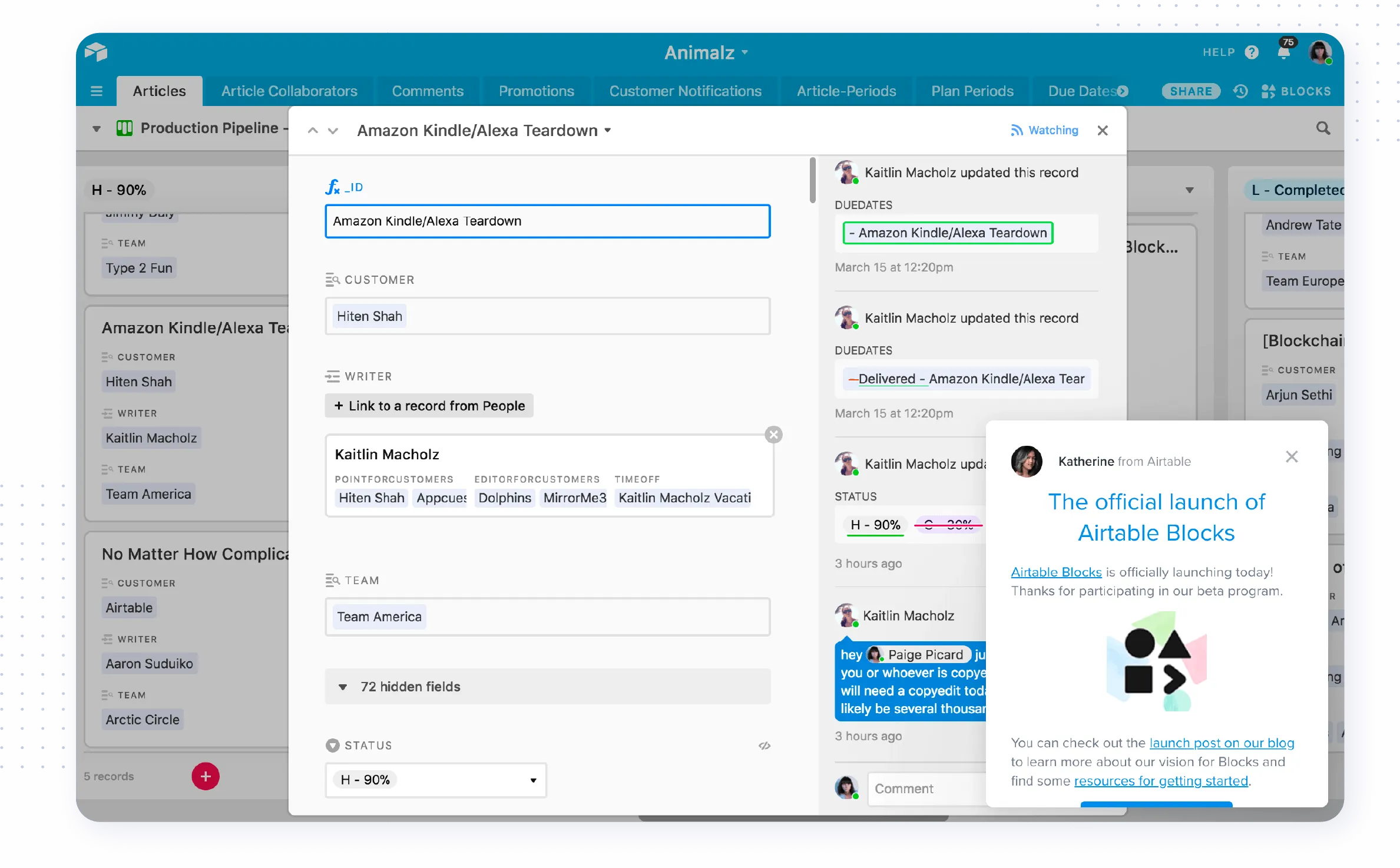
To learn more about getting users to love all of your features, you can read:
• A guide to feature adoption: The key to long-term user retention
• 6 highly effective ways to drive feature adoption using tooltips
• 9 top-notch examples of feature tours and prompts that improve adoption
Even though your world might be all about your product, your users’ lives probably aren’t. You can’t expect that your onboarding flow will be enough to knock people’s socks off and convert them right away.
You need to keep at it—and one way to do this is with emails and notifications that remind people to come back to your product.
You can use emails and notifications to:
• Remind users of an unfinished task
•. Announce new features, updates, or product launches
•. Help users build habits that include your product
•. Prompt users that haven’t logged in for a while
•. Show users the value they’ve already gotten from using your product
One product that uses email to boost adoption rates is the spell-check tool Grammarly. Grammarly is at a disadvantage when getting users to their aha moment because it’s often invisible. With Grammarly’s editing and proofreading tools working away in the background fixing your constant typos, some users might not realize just how much it does for them.
To help get users thinking about their product, Grammarly sends out weekly engagement emails telling users how they match up against other users and how many words it’s checked for them over the last week. This not only gamifies spell-checking, but it also reminds users that Grammarly has been there every step of the way, helping you write emails, college papers, or your totally excellent Fight Club 2 screenplay (the third rule of Fight Club is friendship).
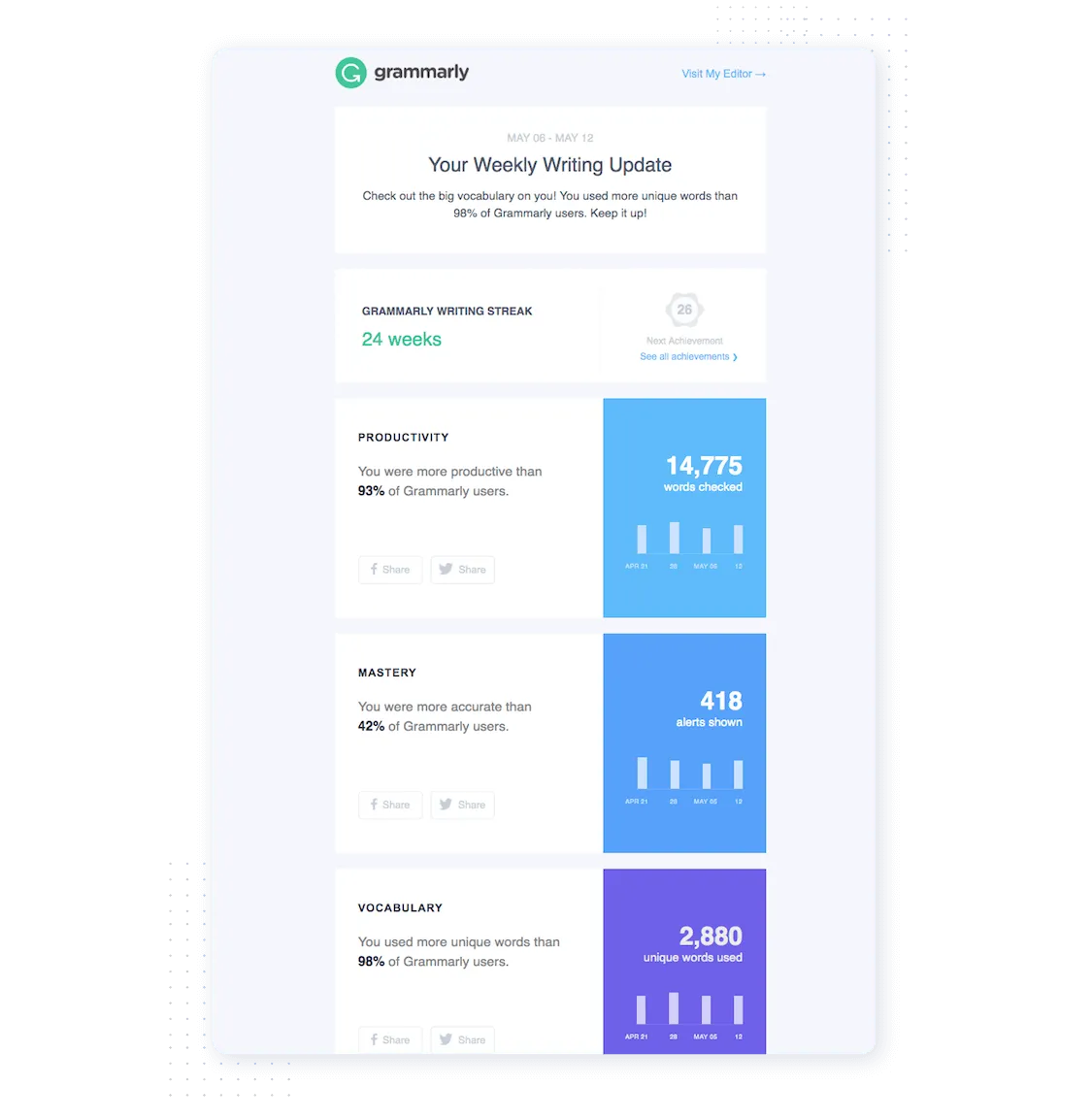
To learn more about how to harness the power of emails and notifications, you can read:
• How to write awesome product launch emails (+14 examples)
• 8 brilliant retention emails that activate customers in limbo
Since product adoption touches on the entirety of a customer’s journey, it’s difficult to pin down one specific KPI to measure how well you’re doing. Instead, measure and track several different metrics to get a sense of your overall product adoption rate and where you can make improvements.
Click-through, conversion, and adoption rates are easily measurable metrics that show you how well you’re doing in easing users through their product adoption journey.
Click-through rates (CTR) measure how likely someone is to see your email, push notification, or in-product message and click on it. If people aren’t clicking, then your messaging, placement, or timing might be off.
Find your CTR by dividing your number of clicks by your number of impressions and multiplying by 100.

Conversion rates tell you what percentage of visitors to your site or free trial users eventually convert into actual users. If your conversion rate is low, it means either you’re attracting the wrong kinds of people to your site or your free trial isn’t doing enough to convince them that your product is worth trying.
Find your conversion rate by dividing your number of conversions by your number of visitors and multiplying by 100.
If you want to focus solely on the efficacy of your free trial, replace the “number of visitors” with “number of people who started a free trial” and do the same calculation.
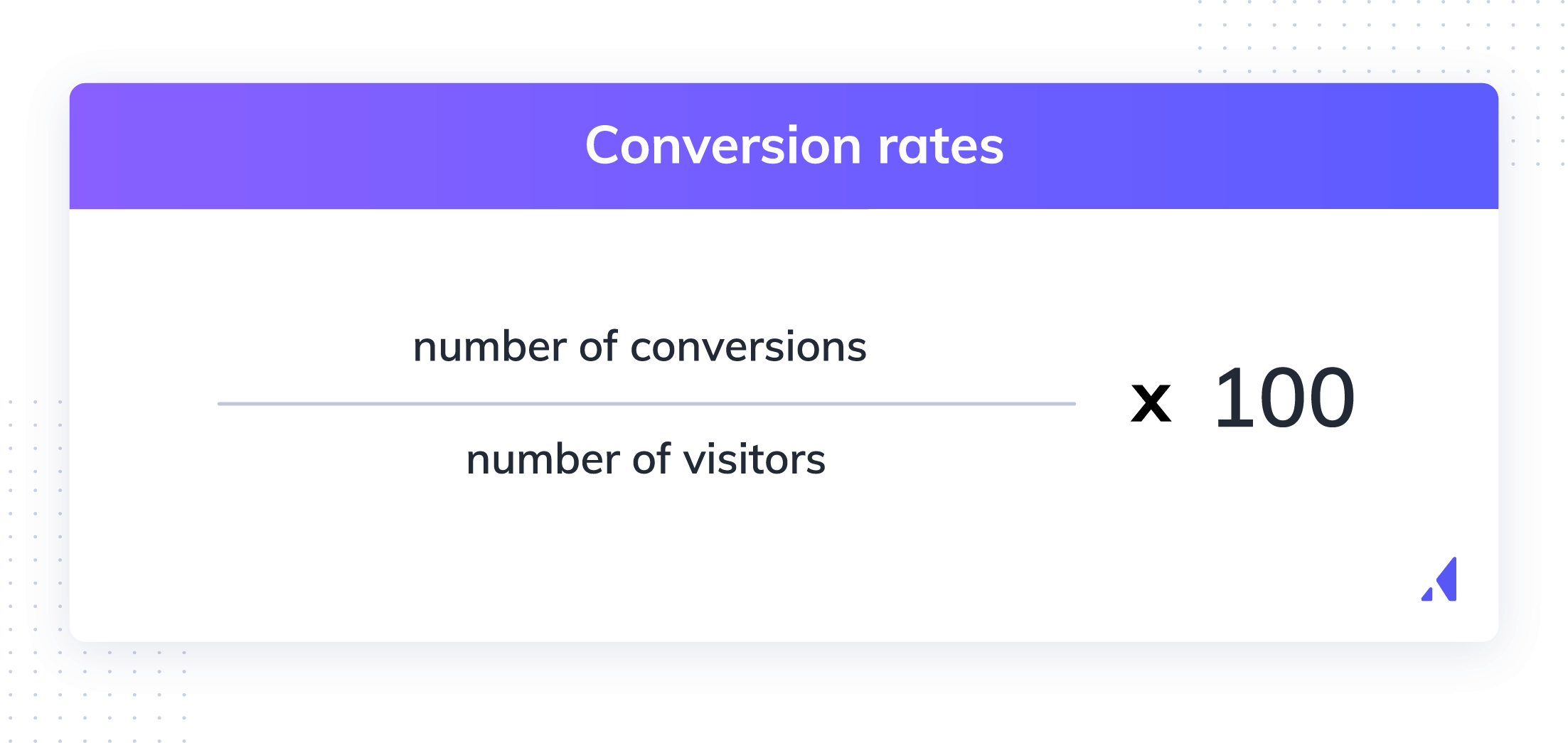
Adoption rates tell you what percentage of users end up using your product’s features. Low adoption rates indicate issues with your adoption and expansion stages. If you’re not doing well here, tweaks to your onboarding flow and engagement strategies might be the solution you’re looking for.
Find your adoption rate by dividing the number of users who use a specific feature by your total number of users and multiplying it by 100.
Each of these metrics won’t measure how well your product adoption is working on its own, but together they help you gauge the health of your overall product adoption strategy.
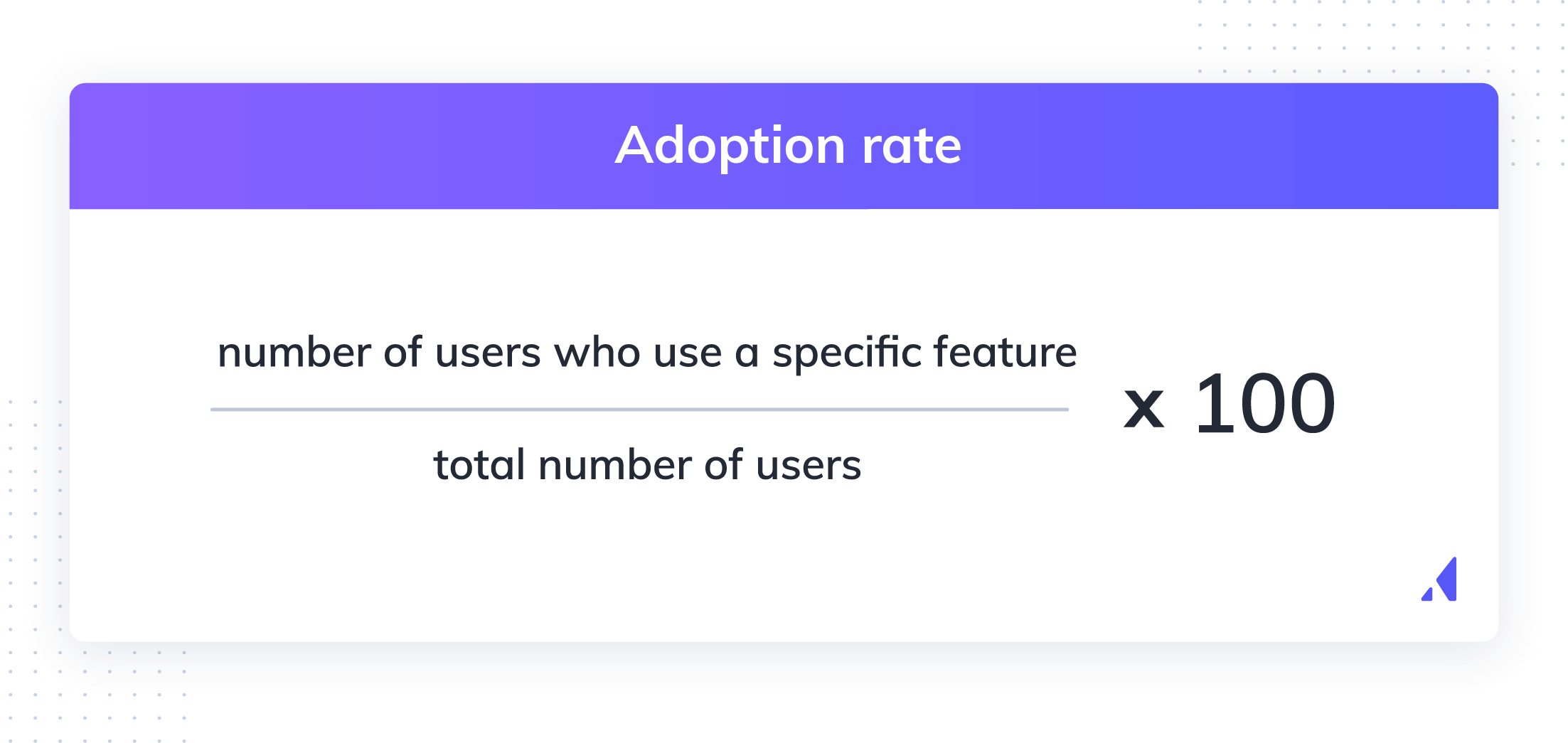
To get a better picture of how well your adoption strategies are paying off, you want to look closer at how “sticky” your product is. A sticky product has users coming back day in and day out. They aren’t just users—they’re power users who’ve genuinely embraced your product’s solution. By tracking your stickiness ratio, you see precisely how engaged different user groups are in a way that adoption rates just can’t show.
To start, you’ll want to know what percentage of your user base uses your product daily, weekly, or monthly. Do this by simply dividing how many unique users log in over a given time frame by your total number of users and multiplying by 100.
To calculate your stickiness, take it a step further by dividing your daily users or weekly users by your monthly active users and multiplying it by 100.
When evaluating your stickiness ratio, consider how often people should use your product. A social media platform might aim to have users log in at least once a day, whereas a banking app may only expect weekly or monthly engagement.
You should also look at these numbers when segmented so you can see how well you’re doing with each of your important user groups. When looking at your numbers altogether, you might miss weaknesses in smaller demographics that could be shored up with optimizations specifically targeted to them.
The final metric important for measuring product adoption is customer retention per cohort. This metric will give you an idea of how long, on average, people use your product. Armed with this information, you can try to implement strategies to extend average retention and increase the lifetime value of your users.
To find your average customer retention per cohort, sort your users into cohorts by their start date and run a cohort analysis. Notice how much of that cohort churns every day over their first month. Ideally, you’ll see that you still have users from that cohort after the end of the month. If not, then your user base isn’t correctly adopting your product, and you’ll need to look more closely at user behavior to determine why.
You’ll want to run the same cohort analysis when sorting your cohorts by demographic. This gives you a sense of how well your product adoption strategies work for each of your most important user segments.
As any data nerd will tell you, there are many ways to read your analytics for valuable insights. If you want to learn more about your numbers, you can check out:
• The 4 customer retention metrics you should be measuring now
• 7 user engagement metrics that give us deeper insight into our users
Despite everything you’ve learned already about product adoption, there’s always more to learn on the horizon. Mastering product adoption is a constantly evolving task as product managers and marketers find new and inventive ways to educate their users and encourage them to adopt their new products.
Here are some more resources you can use to continue to improve on your product adoption strategies:
• Improve your product adoption strategy: A flywheel model
• Product adoption: What it is, why it matters, and how to measure it
• 6 keys to accelerating your product adoption process
• 5 ways PMs can improve product adoption today
• Improve user adoption: Understanding how to remove friction